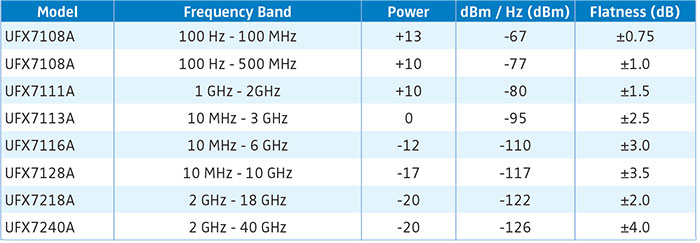Open as PDF
 The development and deployment of 5G technology is changing the way wireless carriers and internet service providers think about meeting the ever increasing demands for higher data rates and more capacity from their customers. The rollout of 5G is being implemented in different ways and there is still a lot unknown about how homeowners, businesses and mobile customers will use emerging 5G networks and devices. Some providers see 5G as a push for increased bandwidth to mobile devices with currently used spectrum, below 6 GHz, while others see 5G as a fixed wireless access replacing legacy wired infrastructure operating in the millimeter wave range of the spectrum, above 28 GHz. Regardless of the approach and deployment the goal of 5G is to provide wireless data rates in excess of 1 Gbps and potentially over 20 Gbps.
The development and deployment of 5G technology is changing the way wireless carriers and internet service providers think about meeting the ever increasing demands for higher data rates and more capacity from their customers. The rollout of 5G is being implemented in different ways and there is still a lot unknown about how homeowners, businesses and mobile customers will use emerging 5G networks and devices. Some providers see 5G as a push for increased bandwidth to mobile devices with currently used spectrum, below 6 GHz, while others see 5G as a fixed wireless access replacing legacy wired infrastructure operating in the millimeter wave range of the spectrum, above 28 GHz. Regardless of the approach and deployment the goal of 5G is to provide wireless data rates in excess of 1 Gbps and potentially over 20 Gbps.
As industry moves towards these higher speeds and use of new spectrum, new components and technology are required to build the radios necessary for 5G deployment. Devices are becoming more tightly integrated, more MIMO devices are being incorporated into designs, and high frequency phased array systems are being deployed. These new devices require new testing techniques in the lab, in production and in the field to ensure the high data rates being quoted are reliable in the real world when in the presence of real world noise and interference.
New technologies being deployed will need to rely on the performance of both high power amplifiers on the transmit side, and low noise amplifiers on the receive side. Quantifying the performance of these amplifiers will be critical to understanding how deployed systems will operate in the real world. Critical specifications like noise figure and noise power ratio can give radio and receiver designers a deep understanding of how the overall system will perform. Noisecom noises sources generate the broadband noise required to do this type of benchmarking and quantify component and system performance across the microwave and millimeter bands.
For over 30 years Noisecom has been designing noise generation devices and instruments for Carrier-to-Noise, jamming, multipath fading, satellite test and calibration across a wide variety of industries. Noisecom has a depth experience unmatched in the industry and works closely with technical end users to find the right product for the application with both off the shelf and customized solutions. This experience and close links to customers and markets has led to the development of noise generators specifically designed for both microwave and millimeter wave bands being used in 5G development and deployment.
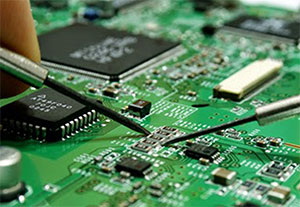 Customization
Customization
Each system is different and the set of RF interference challenges vary in every device or system development and deployment. This diverse range of unique testing requirements is why Noisecom calibrated noise sources and programmable noise generators are highly customizable. Generators and instruments can be designed for different noise power density, internal filtering, and remote control. Whether it is small modifications to frequency and power levels or a fully custom solution, Noisecom has a broad range of capabilities and solutions for every budget.
Amplifier Linearity - Noise Power Ratio
High data rate requirements of 5G are pushing the video bandwidth limits of amplifiers from 10 MHz to 500 MHz and beyond. To deliver these data rates, power amplifiers and low noise amplifiers must be tested to see how they reproduce complex modulated signals with high peak-to-average power ratios. Amplifier performance is important in a system as non-linearities will reduce the dynamic range of the communications channel by limiting the lowest power level of a signal that can be received erroneously. Noise power ratio is a convenient way to test for non-linearities and the measurement can be done at the component or system level.
Traditionally, two-tone testing has been the method used to test for intermodulation distortion of amplifiers but this method has limitations since the signals used do not emulate the higher peak-to-average power ratios that the amplifier is required to handle. The peak-to-average ratio of multiple OFDM signals is much greater than that experienced during the two-tone test. The large peaks stress the amplifier or device under test to a greater degree making the two-tone test less useful and making a noise power ratio measurement a better figure of merit for system performance. Noise power ratio testing is done with a broadband noise source that represents any or all the carriers in the specified operating bandwidth of an amplifier. Using a noise source has the added benefit of being very economical when compared to high-end signal generators required to create tones in the millimeter wave range.
The Noisecom UFX7000A programmable noise generator has the ability to generate wideband white noise up to and beyond 45 GHz and can be configured with multiple filters to target specific bandwidths and frequencies of high peak-to-average power ratios. Testing can be automated with user defined output noise specs and results can be graphed to create noise power ratio curves to determine optimum performance conditions.
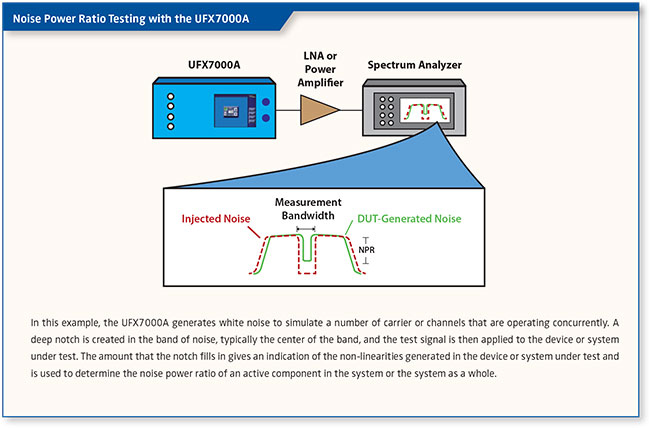
System Performance - Noise Figure Measurement
Noise Figure is a key performance parameter for any RF or millimeter wave component or system. Noise figure gives the designer an indication of the degradation of signal-to-noise in a system due to the noise generated or present in the system. The lower the noise figure value, the better the system performance, the less signal-to-noise degradation. As communication data rates and operating frequencies increase for 5G applications, systems are even more sensitive to signal-to-noise degradation on the communication links and there needs to be a high confidence that what is designed in the lab will be able to operate in the field.
Measuring noise figure can be done in a variety of ways and with a range of different test equipment including spectrum analyzers, noise figure meters, noise figure analyzers, or vector network analyzers. Regardless of the testing technique, any noise figure measurement requires an accurately calibrated broadband noise source. Noisecom offers a range of calibrated noise sources as both coaxial and waveguide components in a variety of form factors with the NC346, NC3000 and NC5000 product lines. Coaxial noise sources are available up to 55 GHz, waveguide noise sources up to 105 GHz, both are designed specifically for noise figure measurement with excellent VSWR and calibrated ENR with typical uncertainty of 0.18 dB.

Over the Air Testing and Chamber Calibration
As chipsets for 5G become more highly integrated devices with on-board power amplifiers and antennas and frequencies increase to millimeter wave range, conducted RF power measurements are now physically impractical or even impossible to perform. These new MIMO devices provide minimal access to test points for making measurements and physical connection for conducted testing is not possible, instead radiated, or over the air testing is required.
To overcome the lack of physical connections engineers are developing over the air testing techniques to quantify and analyze devices inside RF test chambers. These chambers allow devices to be remotely activated and subjected to a variety of tests with transmit and receive antennas inside the chamber. These antennas are typically connected to a variety of signal sources to stimulate the device and measuring instruments like spectrum analyzers, vector network analyzers or power meters to capture and measure the response.
In order to make reliable and repeatable measurements inside any chamber, the chamber and test system as a whole, needs to be calibrated and quantified. Noise sources are the ideal device for this type of calibration process as they provide a known source with calibrated data points which can be used to determine cable loss, air path loss, antenna efficiency, and total chamber response. After the system is calibrated and quantified the same noise sources with known characteristics can be used as a reference source for the device under test to receive signals. Noise sources for over the air testing applications also act as a costeffective alternative to expensive microwave and millimeter wave signal generators.
Noisecom calibrated noise sources cover the full range of microwave and millimeter wave frequencies required for testing of 5G devices in over the air chamber tests. Devices are available up to 45 GHz with bandwidths from 100 MHz to 1 GHz with high peakto-average power ratio in the NC346, NC3000 and NC5000 product lines.
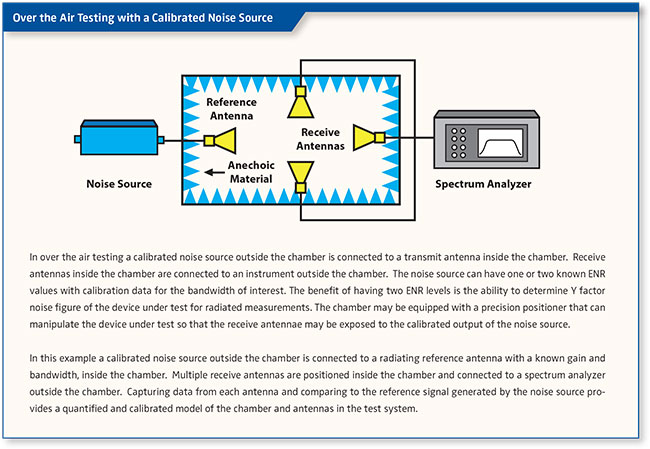
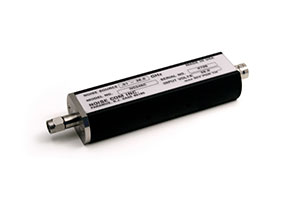 NC346 Broadband Calibrated Noise Source
NC346 Broadband Calibrated Noise Source
The NC346 noise source is designed for precision noise figure measurements using a dedicated noise figure analyzer or a spectrum analyzer with noise figure capability. The low VSWR increases noise figure measurement accuracy.
Features and Benefits
- Broadband coverage
- Extremely good temperature stability
- Superior voltage stability
- Noise figure meter-compatible
Specifications
| Calibration |
1 GHz steps |
| Temperature coefficient |
< 0.009 dB/°C |
| Operating temperature |
0°C to +55°C |
| Input power |
+28 VDC ±2 VDC at 30 mA |

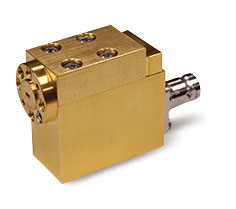
NC5000 Millimeter Wave Noise Source
The NC5000 series noise sources feature outstanding stability, switching speed, and ripple-free response over standard waveguide bands.
Applications
- Noise figure measurement
- Radiometers
- 5G mm wave applications
Specifications
| Noise output rise and fall times |
< 1 μs |
| Noise output variation with temperature |
< 0.01 dB/°C |
| Noise output variation with voltage |
< 0.1 dB/1 %AV |
| Operating temperature |
0 to +85°C |
| Input power |
+28 VDC at 30 mA max |

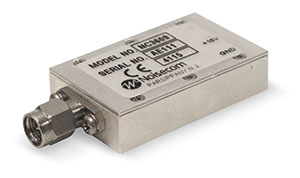
NC3600 Series High ENR Noise Source
The NC3600 offers a high ENR output over a wide frequency range.
Features and Benefits
- Radar systems
- High NF device measurements
- Automated test equipment (ATE)
Specifications
| ENR |
>40dB |
| Standard input voltage |
+15V |
| Flatness |
+/- 1.5dB |
| Typical current |
100 mA |
| Callibration |
Every 1 GHz |
|
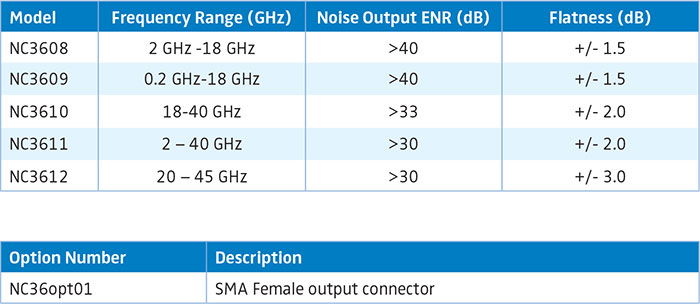 |
UFX7000A Broadband Noise Generators
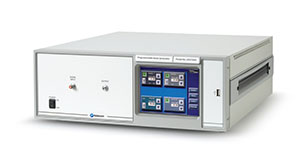 The UFX7000A broadband noise generator has a powerful architecture used to create complex custom noise signals for advanced test systems. This versatile platform allows the user to meet their most challenging design requirements. Precision components provide high output power with superior flatness, and the flexible computer allows control of multiple attenuators, switches, and filter banks. The touch screen streamlines manual control, LAN, GPIB and RS-232 are available for remote control in ATE systems.
The UFX7000A broadband noise generator has a powerful architecture used to create complex custom noise signals for advanced test systems. This versatile platform allows the user to meet their most challenging design requirements. Precision components provide high output power with superior flatness, and the flexible computer allows control of multiple attenuators, switches, and filter banks. The touch screen streamlines manual control, LAN, GPIB and RS-232 are available for remote control in ATE systems.
